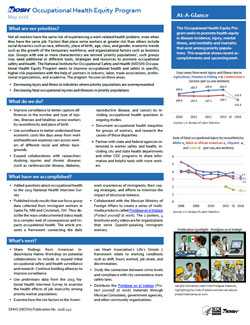Occupational Health Equity Program
May 2016
DHHS (NIOSH) Publication Number 2016-142
 What are our priorities?
What are our priorities?
Not all workers have the same risk of experiencing a work-related health problem, even when they have the same job. Factors that place some workers at greater risk than others include social dynamics such as race, ethnicity, place of birth, age, class, and gender; economic trends such as the growth of the temporary workforce; and organizational factors such as business size. Groups with one or more characteristics are termed ‘priority populations’; such groups may need additional or different tools, strategies and resources to promote occupational safety and health. The National Institute for Occupational Safety and Health (NIOSH) Occupational Health Equity Program seeks to improve occupational health and safety in specific, higher-risk populations with the help of partners in industry, labor, trade associations, professional organizations, and academia. The program focuses on these areas:
- Decreasing injury and illness in industries where priority populations are overrepresented
- Decreasing fatal occupational injuries and illnesses in priority populations
- Page last reviewed: June 6, 2016
- Page last updated: June 7, 2016
- Content source:
- National Institute for Occupational Safety and Health Education and Information Division


 ShareCompartir
ShareCompartir